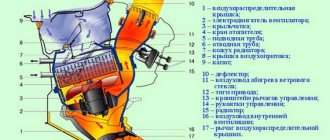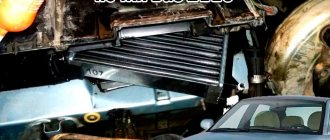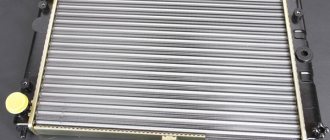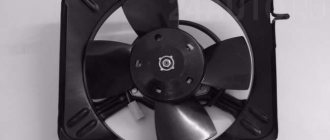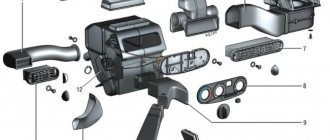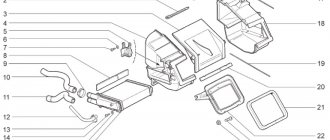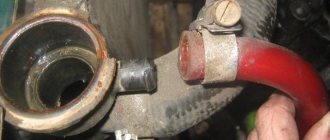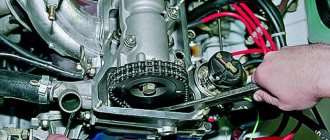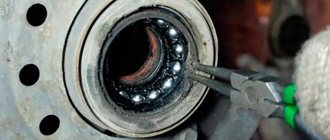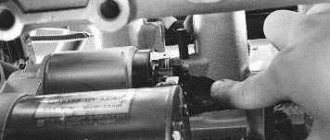It is necessary when it has leaked and repairing the crack has not brought positive results, or when the radiator is so clogged with dirt that the engine begins to overheat. To replace the radiator, you must purchase a new one, first visually checking it for signs of impacts or visible cracks.
Radiators are available in two types: copper or aluminum. A copper radiator is more expensive, but it is more reliable, both in terms of heat capacity and the possibility of repeated repairs. If you purchase an aluminum radiator to replace a VAZ cooling radiator
, then you need to take into account that it needs a new set of pipes.
The coolant is drained through the block plug or, if there is none, through the radiator plug. On copper radiators, when draining through the radiator plug, you must use two keys. Hold the threaded part soldered into the radiator with one, and unscrew the plug with the other. Otherwise, you can break off the threaded part from the radiator tank, since it is only soldered there. The electric fan is removed (on engines with an electric drive), after first distributing its connector in the wiring. The upper and lower radiator pipes are removed. The radiator mount itself is given away. The old radiator is removed.
Before installing a new radiator, you must check the seating rubber inserts on which the radiator rests. If they become unusable, they are replaced. Having installed the radiator and secured it to the engine compartment shield, connect the upper and lower pipes. Install the electric fan and connect its terminal block. Replace the cylinder block drain plug.
Before adding coolant, check it for serviceability. If it has lost its color or there is a lot of rust, it needs to be replaced. The fluid is also changed when its service life is unknown, for example, if the car was bought second-hand.
To prevent air locks from forming when pouring antifreeze, the bypass valve (valve for releasing air from the cooling system) is opened, and if there is none, the hose is removed at any highest point of the cooling system.
For example, when replacing the cooling radiator of a VAZ
The tube is removed from the intake manifold under the carburetor. Then, when pouring antifreeze, you need to wait until coolant comes out of the tube, which means that the air has been squeezed out and it can be put back in place. The same is true with the bypass valve, when air stops escaping and clean antifreeze flows out without bubbles, close it.
After filling the antifreeze, the engine is started and the system is checked for leakage of antifreeze at the connections. If necessary, tighten the clamps. This completes the replacement of the cooling radiator.
Any internal combustion engine needs a good heat sink. For this purpose, the car is equipped with a cooling radiator. The VAZ-2110 is also equipped with it. Over time, its performance characteristics deteriorate. Therefore, motorists are faced with the question of replacing it.
Changing the VAZ 2110 cooling radiator with your own hands
Even for people who are quite far from technology, the purpose of a cooling radiator is clear - it removes excess heat from the engine, thereby preventing it from overheating and failing.
However, some time passes, the most important part of the cooling system may fail, or simply leak. Then there is a need to replace the cooling radiator of the VAZ 2110, which can be done not only at a service station, but also with your own hands.
New engine cooling radiator
Replace or repair the radiator
If your car has a copper or brass radiator that has leaked, then it not only can, but also needs to be repaired. After all, the cost of such a device is quite high, so buying a new copper radiator will cost a pretty penny. If you prefer to install a copper cooling radiator on Lanos, then you can make it to order. There is also an option to install a heat exchanger from VAZ cars.
Conventional aluminum radiators, which are installed on Lanos from the factory, cost 5 times less than copper ones, so if they are found to be faulty, it is better to replace them. To repair an aluminum heat exchanger, you will need special soldering equipment. In addition, even after carrying out these soldering works, such a device will not last more than 1-2 years. It is rational to repair the Lanos aluminum cooling radiator (link) yourself if a leak occurs at the junction of the tank with the honeycomb.
This is interesting!
If the radiator on Lanos leaks, it needs to be replaced. This is the opinion of many car owners who have repeatedly tried to repair the device, but in the end came to a common opinion about the rationality of replacing the heat exchanger.
Device
Any radiator on a car, regardless of its brand, consists of:
Design (diagram) of the engine cooling system
The body, which can often be made of aluminum, less often copper, consists of two tanks (one on top, the other on the bottom) and adjacent pipes through which the coolant circulates.
The core is rows of brass tubes soldered to cooling fins. They are located inside the case.
Cooling liquid enters the radiator through the filler plug and is drained through the drain valve, if necessary.
In addition, the power unit for maintaining thermal conditions includes an electric fan and a thermostat.
Experts recommend
You can reduce the likelihood of premature failure of the radiator of the engine cooling system by following the maintenance schedule. The recommended replacement interval is prescribed by the manufacturer.
The coolant should be changed after a mileage of 80 thousand km. The regular replacement process will ensure that scale and rust are removed that are blocking the free circulation of coolant.
When replacing a failed radiator, it is recommended to simultaneously change the thermostat and radiator hoses.
It is important not to forget that flushing the entire system is a prerequisite, which removes all dirt and remnants of old fluid.
Use antifreeze at low t0, do not use water. Otherwise, the car may not start and the water may freeze. At the same time, some parts fail or burst. As a result, radiator repairs are inevitable.
Dismantling and installation
To remove the cooling radiator from a VAZ 2110 with your own hands, you must:
That is, removal is quite simple. Now, if the radiator leaks slightly, but is not severely damaged by corrosion, you can repair it. Otherwise, replace it. When choosing a new radiator for a VAZ 2110, be sure to take into account the model of the previously installed one so that the new one fits perfectly.
When installing, make sure that the rubber pads on which the body rests with the lower part fit firmly into the holes on the cross member.
Next, you need to fill in the coolant (you can use the old one by filtering it), and then start the engine.
Source
Installation
Installation is carried out in reverse order. Pay attention to the rubber pads on which the heat exchanger stands. If they have cracks, they should be replaced with new ones. The same applies to pipes. It is advisable to replace the clamps as a whole. And install the pipes themselves on Litol.
So, we found out what the price of a VAZ-2110 radiator is and how to replace it with your own hands.
As a rule, most car enthusiasts begin to pay attention to the cooling system only when it begins to fail, which, according to statistics, happens quite often. Meanwhile, most of the problems that arise during the operation of a car are caused by a malfunction of the cooling radiator. And there is a logical explanation for this: the cooling system is forced to function not in the most favorable conditions.
Often the operating temperature in it comes close to 120 degrees, which, combined with high pressure, does not in any way contribute to the safety of the radiator and other elements of the cooling system.
At the same time, one cannot discount the banal aging of the car’s cooling radiator, which is why it has to be replaced. But we will discuss in this article how this can be done on different models of domestically produced cars.
| The content of the article: |
We remove the cooling radiator on a VAZ-2110 to replace it with our own hands (+part numbers)
Problems with the cooling system necessarily lead to more serious problems with the engine. And the backbone of this system is the cooling radiator. At the slightest sign of malfunction, you need to think about either repairing or replacing the radiator completely . But first you need to decide which radiator is better for the VAZ-2110 and which one was installed from the factory.
Choosing a radiator for VAZ-2110
The part is not cheap, but the stingy one pays twice. Therefore, in the case of a cooling radiator, it is better to overpay a hundred or two, but provide your engine with a normal operating temperature and save it from overheating.
The original radiator of the VAZ-2110 has lugs for fastening, but some manufacturers produce models without these fastenings.
Signs of malfunction and breakdown
The signs of a malfunctioning radiator that needs to be replaced are clear - an irreparable leak and puddles under the car.
Leaks can be caused not only by physical damage, but also by poor-quality coolants. In any case, repairing radiators using magic additives that close cracks and holes is detrimental to the engine. No one can say that this product will clog the cooling system. Therefore, there are two options - replacement or repair.
Articles
Sometimes repairing a radiator is completely impossible, and sometimes it will cost more than a new one. Therefore, we will immediately consider the market offers and the model. And there are only two models - for the 1.5-liter carburetor engine and for all the others. Later models for all injection engines are suitable for both Priora and Kalina. An old radiator for a carburetor engine has catalog number 2110-0810106000 and costs about 1000-1500 rubles. A new one with article number 2172-1300010, 2112-1301012, 21102-1301012, 2170-1301012-95 can cost from two to six thousand.
On “tens” since 2008 with radiators.
The price of a VAZ-2110 radiator depends on the material and manufacturer:
Copper radiator 2-row.
Aluminum radiator 2112-1301012.
The cooling system does not work well, causes and solutions
- Clogged radiator pipes. This phenomenon, today, is very rare, and only when using low-quality coolant. In this case, the pipes should be replaced.
- Low coolant level as a result of cracks in the pipes or leaks at their attachment points.
- Housing contamination. One small detail should be taken into account here - the whole car, the radiator in particular, needs care. Do not allow it to become overgrown with fallen leaves, dirt and other debris, as this will significantly reduce its efficiency.
- There is another reason for the failure of the cooling system - the appearance of a leak in the radiator. Dismantle it so that, based on the location of the leak, its size and the general wear and tear of the device, you can decide whether it needs replacement or repair.
Removing the cooling radiator on a VAZ-2110
Regardless of what we have to do, replacement or repair, the radiator needs to be removed . The operation is simple and will only take a few minutes, and all you need for the job is a container for draining antifreeze and a standard set of tools.
It is more convenient to carry out the work with access under the car, and we drain the antifreeze on a cold engine.
Unscrew the tank cap.
Removing and replacing the cooling radiator
Detailed procedure for removing the radiator on a VAZ 2110 car with video support. This information will help in replacing it on other machines.
A modern car is a complex system of interconnected parts. Violation of the normal operating mode of any of them will ultimately lead to the breakdown of several others. A clear example for this statement is cases of radiator failure.
The radiator of the cooling system is one of the most vulnerable parts of a car. Having a thin brass body with a large number of soldered joints, it is more susceptible to mechanical deformation than any other part. And in simple terms - a breakdown from the blow of a accidentally flying stone or tree branch.
The second common cause of radiator breakdowns is the destruction of solder and contact welding points. It is in this case that the mutual influence of the car’s elements has a destructive effect: long-term use of chemicals weakens the contact zone, violation of the operating mode of the pump or thermostat increases the temperature of the coolant, a stuck lid valve does not allow the pressure to be released in time and as a result we get many leakage points.
There are many more reasons why the radiator may need repair, but this is already a topic for another very voluminous article, and in this review we will briefly tell you how to properly remove the radiator of the cooling system of a VAZ 2110 car if a leak is suddenly discovered.
Removing and replacing the radiator:
1. The battery will interfere with dismantling, so it must be removed.
2. To drain the coolant, you must remove the ignition module. Now, having access to the plugs on the cylinder block and on the radiator, we drain the coolant into a previously placed container.
3. If the car is equipped with an injection system, you must remove the air filter.
4. Disconnect the wires leading to the fan. To do this, disconnect the branded block on the fan and cut the clamp securing the harness.
5. Release the throttle linkage, which is attached to the fan casing.
6. Having previously loosened the clamps, remove the cooling system pipes from the thermostat mounting fittings.
7. Disconnect the steam outlet pipe leading from the radiator to the expansion tank at the point of its attachment to the tank. We remove the clamp.
8. Remove the steam outlet pipe from the clamps securing it. Typically, these clamps are located at two points. The first is on the expansion tank hose.
9. The second is on the water pump pipe.
10. We disassemble the upper mount of the radiator to the car frame (this way we simultaneously release the fan).
11. We take out the radiator from the VAZ 2110 car. In order for it to “come out” without problems, you need to tilt it towards the engine.
12. Disconnect all hoses and the fan from the removed radiator. To do this, loosen the clamps and disconnect hose No. 1 (discharge), hose No. 2 (supply) and hose No. 3 (steam removal) from the radiator. Next, unscrew two bolts and nuts.
13. If there are landing pads left on the lower pins, remove them and assess their condition. In case of deformation or cracking, we replace them with new ones.
After this, the removal of the VAZ radiator can be considered complete. Now we determine where the leak is in the radiator by supplying air with a pressure of no more than 0.2 MPa and immersing it in water. But the right decision would be to entrust this procedure to professionals. Although there is nothing difficult here.
14. Replacing the radiator of a 2110 model VAZ car with a new one occurs in the reverse order. But, before installing a new or repaired radiator on a car, we check the condition of the rubber bushing of the upper mount. In case of wear, we replace it with a new one. We install the fan, fixing its casing.
15. Install the radiator on the workplace, performing all the steps of this instruction in reverse order, just initially do not forget to put the lower mounting pads on the radiator fonts.
16. The very last step in replacing the radiator will be pouring antifreeze (antifreeze) into the cooling system. To do this, read in detail the article entitled: “Replacing the coolant in a VAZ 2110.”
1. Replacing the cooling radiator on a Chevrolet Lanos:
2. For Ford Scorpio GFR 2.0:
Video: purging the radiator and replacing the fan on a Ford:
Source
Device, principle of operation
The design of the VAZ radiator assumes the presence of the following elements:
As for materials, the body can be made of copper or aluminum. Rubber pipes are attached to it. Coolant circulates through them. The core is a series of brass tubes. They are soldered to the cooling fins. Antifreeze enters the system through the top filler valve. There is a tap at the bottom to drain the liquid. In addition, the design includes an electric fan. It produces forced air circulation.
Causes and solutions to leaks
It is important to monitor the refrigerant level in the system. There are special marks in the expansion tank for this purpose. If the level constantly drops and you have to add fluid, then the system is leaking. We need to look for the cause and eliminate it quickly. Let's look at the main reasons for leakage and ways to solve the problem:
One of the reasons for antifreeze leakage is a poor seal of the radiator cap.
A large hole in the radiator is noticeable; thick steam flows through it and antifreeze sprays
Finding a large hole will not be difficult - hot steam will pour out of it. It is difficult to eliminate such a defect on the road. Get to the nearest service station quickly and have the heat exchanger repaired or replaced. In any case, the old radiator will have to be dismantled and inspected. Some craftsmen know how to weld holes. If the radiator is made of copper or brass, then it can be soldered. Aluminum is repaired using argon welding.
A heat exchanger made of copper or brass can be soldered using a powerful soldering iron. An aluminum radiator is welded using argon welding
Experience shows that such repairs can rarely be carried out efficiently, and after just a few months the car owner is forced to replace the radiator with a new one.
It is more difficult to detect a small leak, but the antifreeze itself will help in the search. Its chemical composition contains a dye that is illuminated under ultraviolet light. Just shine a special lamp on the radiator and you will see where the coolant is leaking.
A defect discovered in a garage is eliminated using cold welding. This is a two-component epoxy resin. The prepared composition is similar to plasticine and is applied to the detected defect. Pre-clean the surface: remove dirt, oil and dust. After 15-30 minutes, the weld hardens and the leak is eliminated.
Two-part epoxy resin helps repair radiator leaks in garage environments
There is an opinion that you can eliminate a small leak using folk methods, for example, using dry mustard. This product is added to the radiator; under the influence of temperature, the particles increase in size, spread throughout the system and, where there is a leak, close the hole. Remember that once the defect is eliminated, foreign substances clog the entire system: engine channels, radiator honeycombs. Do not use traditional methods. Find another option to get to a service station or use radiator sealant.
Diagnostics using a video example
Reasons for replacement
The radiator is not a consumable item, and therefore its service life is not regulated. Moreover, this figure can vary significantly for the same car and range from three to ten or more years. It all depends on the quality of the fluid that was poured into the system, as well as on the frequency of its replacement. If you do not change the antifreeze in time, it begins to precipitate. Because of this, the throughput of the tubes deteriorates. This can lead to deterioration of heat transfer and, as a result, to overheating of the engine.
Another reason for replacing the cooling radiator on a VAZ-2110 is a breakdown of the element. Moreover, it may not be so obvious. For example, a motorist can replace a small amount of fluid leaving the expansion tank. This occurs due to depressurization of the housing. And if previously these radiators were repaired, now it will be easier and faster to replace them entirely.
Pro tips on why you need to know the model of the old one when choosing a new radiator
When purchasing a new radiator, be sure to check what type of device your vehicle is equipped with, since the radiator model, as a rule, depends on the volume of the power unit and can be either new or old.
As a rule, a modern car, be it a domestic model such as the VAZ 2109 or a foreign car, is a complex system of parts interconnected with each other. If even one link in the chain breaks, it will ultimately lead to the breakdown of others. A car is like a living organism, and for a VAZ 2109, replacing a cooling radiator is a process that will help save not only some parts, but also the engine itself, because a faulty radiator will not cool it properly. Replacing the VAZ 2109 cooling radiator is a mandatory job that you can easily do with your own hands.
What is the price for a VAZ-2110 radiator?
The cost of a heat exchanger directly depends on the material from which it is made. We said earlier that there are copper and aluminum radiators. The cost of the latter is an order of magnitude less. The most affordable in terms of cost is the Luzar radiator. It can be purchased for one thousand rubles. The product costs about one and a half thousand.
The aluminum radiator is lightweight. However, it has less heat dissipation. In addition, an aluminum radiator corrodes faster. As for copper products, they are heavier in mass. However, they are distinguished by high efficiency, which is 40 percent higher than that of aluminum analogues. The cost of a two-section copper radiator is five and a half thousand rubles.
Choosing something new
Before removing the cooling radiator from your VAZ 2110, you need to think about what unit will be in its place. There are not many options, but the choice should be made wisely.
Kraft model
For the domestic “ten” there are two types of cooling devices - aluminum and copper
And here it is important to think about what exactly you want - reliable, long-term operation, or minimal financial costs for its purchase
- Aluminum. They are light in weight and quite cheap. Prices directly depend on the manufacturer. But such radiators have poorer thermal conductivity and do not cool the engine as effectively. Plus, aluminum units are characterized by the appearance of corrosion after a short period of operation. Among the most popular models, we note two: Luzar. Its cost is now about 1000 rubles;
- Pramo. You will have to pay about 1600 rubles for it.
Test of modern sealants
To increase the tightness of the cooling system and eliminate leaks in the radiator, special sealants are offered to car owners. They are also called “Stop-flow”.
The attitude towards sealants is ambivalent. Same as for engine oil additives and fuel tank tablets. The opinion of car manufacturers is negative. In car maintenance books, in the section devoted to the engine cooling system, there is not a word about “Stop-leak” additives. Their answer to a leak is to replace the radiator with a new one.
But what to do if the antifreeze level drops sharply on the road and the destination is still quite far away? There is an exit. Stores and gas stations sell additives that can help fix leaks. This is an emergency method that allows you to get to the nearest service station without any problems. Sealants cannot permanently cure a radiator from leaking. The main problem with additives is the formation of excess deposits in the car’s cooling system.
Replacement
Before removing the radiator on a VAZ-2110, you need to drain the old coolant. Open the hood and place a container under the bottom of the heat exchanger. We unscrew the drain tap using a 13mm wrench. To prevent a vacuum from forming in the system, unscrew the cap of the expansion tank. This will make the liquid flow much faster.
Since the system uses an electric forced cooling fan, this must also be disconnected. First, unscrew the terminal from which it is powered.
Next, we find two mounting bolts on the sides. We unscrew them with a spanner or wrench. After this, unscrew the third bolt. It is located at the bottom of the electric fan. Then you can safely remove it from the fastenings to the outside.
But the replacement of the VAZ-2110 cooling radiator does not end there. Since the heat exchanger is connected to the system using pipes, they must also be removed. These rubber elements are located along the perimeter from the bottom and top. Using a Phillips screwdriver, unscrew the fastening clamps.
How to further replace the cooling radiator on a VAZ-2110? Then you should carefully disconnect the pipes. Please note that they may be jammed tightly in the holes. Therefore, you will have to use force. Try not to damage nearby hanging elements. After this, you can remove the old radiator out. You need to take it out at an angle (towards the engine), otherwise it will rest against the “TV”.
Removing antifreeze from the cooling system
Coolant (antifreeze) is highly toxic and requires precautions when working. The first thing you need to make sure before draining the antifreeze is that the engine has cooled down. On a hot engine, the coolant is under pressure and if you try to open the radiator tank or remove the clamp from the hose, it can burst out in the form of a hot fountain, which can cause serious burns. For the same reason, you should not check the fluid level on a hot engine by opening the expansion tank cap.
After making sure that the engine has cooled down, open the cockpit of the interior heater radiator. To do this, the upper heater control lever must be moved to the extreme right position.
After this, the work is transferred to the engine compartment. The procedure is as follows:
- Place a container with a volume of at least 10 liters under the drain hole.
- Unscrew the coolant drain plug, which is located in the lower left corner of the radiator. Liquid will begin to flow out.
- Remove the expansion tank and radiator filler caps. This will prevent vacuum in the system and speed up the process of antifreeze leakage.
- Remove the expansion tank by unfastening the fastening clamp. Lift it up to remove coolant from the hose. Place the tank in place and secure it.
- When antifreeze stops flowing from the radiator, place a container for draining the antifreeze under the drain hole in the engine block.
- Unscrew the drain plug using a 13mm wrench and drain the remaining fluid from the cylinder block.
- Tighten the drain plugs in the radiator and cylinder block.
